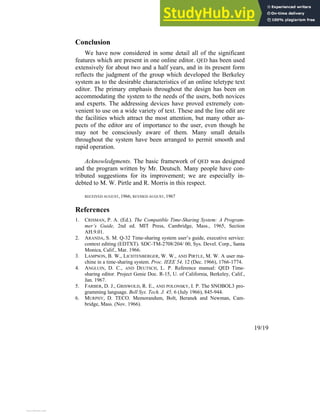1. The document describes an online text editor called QED that was developed for the Berkeley time-sharing system. QED allows users to create and modify text stored on the computer system in an interactive manner.
2. QED uses a line-oriented structure but can handle text of any form. It provides basic editing commands like INSERT, DELETE, and PRINT as well as more advanced features like searching text by content and character-by-character editing.
3. Addressing lines by absolute number alone is not sufficient, so QED allows lines to be addressed by labels or content using search strings to find the desired line, providing flexibility in how the text is organized.
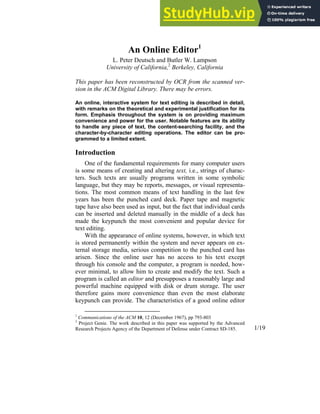
![2/19
and some of the techniques which can be used in implementing it
are the subjects of this paper.
The number of such editors known to the author is not large.
Time sharing systems on the 7094 at Project MAC [1] and the
AN/FSQ32 at the System Development Corporation [2] have them,
and at least two have been written for the PDP-1 [6]. The present
paper is built around a description of the editor in the Berkeley
time sharing system for the SDS-930 [3, 4], which is called QED.
An attempt is made to discuss all the valuable features which have
been built into editors for teletypes or typewriters, with the excep-
tion of the “runoff” [1] facility for producing properly formatted
final documents. Systems for CRT displays are not considered,
since many of their design considerations are quite different.
The most important characteristic of an editor is its conven-
ience for the user. Such convenience requires a simple and mne-
monic command language, and a method of text organization
which allows the user to think in terms of the structure of his text
rather than in some framework fixed by the system. In view of the
speed and characteristics of a teletype, there are substantial advan-
tages to a line-oriented system. However, the physical mechanism
of the teletype makes it difficult to deal with individual characters,
and the speed makes a larger unit somewhat inconvenient.
Fortunately, line orientation does not impose any restrictions
on the text which can be handled by the editor, since all forms of
text fall of necessity into lines. Preservation of this generality is
one of the important design criteria, and it will be seen from the
description below that very little has to be sacrificed to this end.
In order to allow the user to orient himself in the text, the con-
cept of searches or content addressing has been introduced. In its
simplest form, a content address allows the user to reference the
lines of his text by the labels which he has naturally attached to
them in the course of the construction. More general searches al-
low him to find occurrences of specified strings of characters. This
device allows the user a maximum amount of freedom to arrange
his text as he sees fit without compromising his ability to address
it. Many particular conventions can be accommodated within the
general framework.
The basic characteristics of QED are line organization and con-
tent addressing. For the casual user of the system, four or five
commands and understanding of the addressing scheme will pro-](https://image.slidesharecdn.com/anonlineeditor-230806150648-94a203cd/85/An-Online-Editor-2-320.jpg)
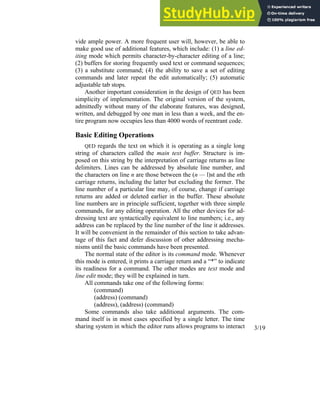
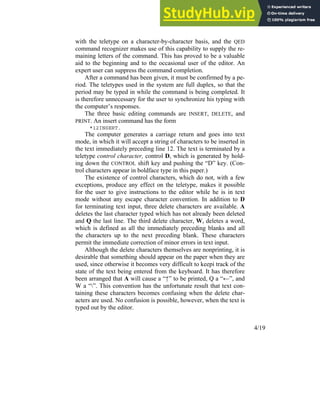
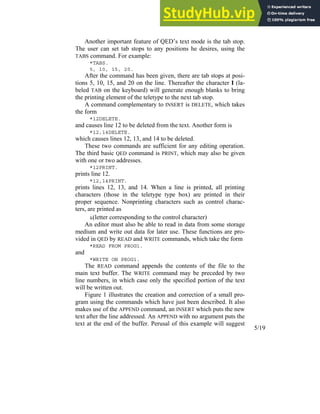



![9/19
powerful addressing mechanism. An attempt to edit a 1000-line
program would illustrate this point even more forcibly. It is neces-
sary to be able to address a line by its contents as well as by its lo-
cation. The simplest way to arrange this is to provide each line
with a sequence number, generated either automatically by the edi-
tor or manually by the user. The lines are kept ordered by sequence
number and can be addressed directly. There are two objections to
this scheme.
(1) It requires the user to concern himself with an artificial de-
vice which has no relevance to his text but nonetheless intrudes on
it, wasting space and time on output and reducing its usefulness as
a document.
(2) Insertions and deletions will eventually force renumbering
of the lines. When this happens, a complete new listing must be
generated if the sequence numbers are to be of any use. Further-
more, as a result of this process numbers do not stay attached to
lines.
A more satisfactory scheme is a more general kind of content
addressing. In its simplest form this allows the user to refer to the
line
XYZ ADD =14
with the address :XYZ:. The meaning of this construction is that the
text is to be searched for a line beginning with the characters inside
the colons, with the requirement that they be followed by a charac-
ter which is not a letter or digit. A line such as
XYZA SUB = 24
will therefore not be found. The search begins with the line after
the one last accessed and continues, cycling to the beginning of the
buffer if it runs off the end, until a line beginning with the speci-
fied string is found, or until the entire buffer has been scanned. In
the latter case, QED prints “?” and awaits a new command.
This kind of content addressing, called label addressing, is
convenient for many kinds of text, including most programs. It is
also possible, however, to search for a line containing any string of
characters in any position by using the construct [(string)], where
(string) refers to any string of characters not containing “]”.
The usefulness of content addresses is enhanced by the fact that
they may be followed by integer displacements, positive or nega-
tive. Thus in Figure 1, the third line could be addressed in any of
the following ways:](https://image.slidesharecdn.com/anonlineeditor-230806150648-94a203cd/85/An-Online-Editor-9-320.jpg)
![10/19
3
6-3
10-9+2
:10:+2
:20:-2
[1 = 1]
[101, SUM]-3
since :10: refers to line 1
since :20: refers to line 5
since only line 3 contains the string “1=1”
since only line 6 contains the string “101, SUM”
The search can be started at any line, rather than at the current
one, by putting the starting line immediately before the search con-
struct. Thus in Figure 1, 4[I] would find line 6, as would
:20:[101].
Two minor devices offer additional convenience. The character
“.” refers to the current line and the character “$” to the last line in
the buffer. The “current line” is defined according to rigid rules
which are set forth in the listing of Table I. The reason for this
careful specification is that an experienced user of the editor makes
frequent use of “.” in performing insert and delete operations. If he
cannot be perfectly sure of its value, he is forced to print the lines
he intends to work on before doing the edits, which is very time-
consuming.
Another very useful convention is that “.” is assumed as the ar-
gument of a command which is given without one. Thus PRINT,
will print the current line. Exceptions to this rule are READ and AP-
PEND, which assume “$” unless told otherwise, and WRITE, which
assumes “1,$”.
Two minor commands permit an address to be displayed either
as an absolute line number (= command) or in symbolic form, as
the label of the nearest preceding line which does not begin with a
blank or asterisk, followed by an integer displacement (← com-
mand). Thus with the text of Figure 1 in the buffer, QED would re-
spond to :10:= with 1, to :100:= with 7, to 6← with :20:+1, to
[SUM+X]-1← with :10:+3.](https://image.slidesharecdn.com/anonlineeditor-230806150648-94a203cd/85/An-Online-Editor-10-320.jpg)

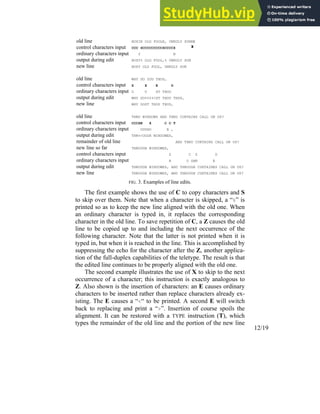
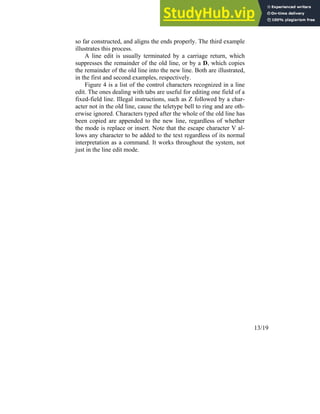

![15/19
Figure 5 is a repetition of the edit performed in Figure 1. The
same errors are made, but many of the features described above are
used to speed the process. It illustrates the MODIFY command,
which is identical to EDIT except that it suppresses the initial print-
ing of the old line.
Substitution
An alternative method of altering a few characters in the mid-
dle of a line is the SUBSTITUTE command, which is modeled after
the CHANGE command in the Project MAC editor [1]. Its simplest
form is illustrated by the following example. Suppose the current
line is
NOW IS THE TIME FOR ALL GOOD MEN . . .
Then the user’s command
SUBSTITUTE /DAY/ FOR /TIME/ would result in
NOW IS THE DAY FOR ALL GOOD MEN. . .
* APPEND.
10 REARA•D, 100, N
SUM = 0
DO 20 I = 1, 1, N
D
*:10:MODIFY.
ZD SD
10 READ% 100, N
*APPEND.
READ 101, X
20 SUM - SUM Q•
20 SUM = SUM + X
WRITE 201, S, W101, SUM
100 FORMAT (6I)
101 FORMAT (F10.5) END
D
*:100:MODIFY.
Z( 16D
100 FORMAT (16)
:10:+2MODIFY.
Z, N, 1D
DO 20 I = 1, N, 1
FIG. 5. The example of Figure 1 redone. The lines paired with braces are the
editing characters in a line edit (above) and the characters typed out during the
edit (below).](https://image.slidesharecdn.com/anonlineeditor-230806150648-94a203cd/85/An-Online-Editor-15-320.jpg)

![17/19
and come immediately after the initial “S”. Because of this conven-
tion, “:” may not be used as a delimiter. The most important op-
tions are listed in Figure 7. For example,
1,$SUBSTITUTE : I/ALPHA/ FOR /BETA/
will change the first occurrence of “BETA” in the text buffer to
“ALPHA”.
String Buffers
Although QED is not a programming language, it does have one
feature which makes it possible, among other things, to write sim-
ple programs in it, and that is the 36 string buffers, identified by
the digits 0 through 9 and the letters A through Z. Each string
buffer can be loaded with an arbitrary string of characters, either
from specified lines of main text buffer or from teletype input. The
buffer can be called by the two characters Bn where n is a letter or
digit. The editor then behaves exactly as though the characters in
the buffer were being typed in on the teletype.
This fact has a number of implications. First of all, it permits
the user to insert a frequently used phrase in the text by typing just
two characters. Secondly, it permits him to move around sections
of his text by loading them into string buffers and inserting the
buffers at the desired points. To facilitate this operation, a com-
mand is available which loads a section of the text buffer into a
string buffer and deletes it from the text buffer.
Thirdly, it is possible to put frequently used commands into
string buffers. The existence of the escape character, V, which
causes the next character to be taken literally no matter what it is,
allows control characters such as A to appear in buffers. In particu-
lar, it allows calls on other buffers to appear in a buffer, and the
convention that a call on the buffer itself is taken as a loop com-
mand permits simple functions to be performed repeatedly. For
example, if the string
.+M.CSSSDBA
is put into buffer A, then a call on this buffer in command mode
will cause the second, third, and fourth characters to be removed
from every line in the buffer following the current one.
The possibility of extending this elementary program-writing
capability in QED has been seriously considered. The most obvious
addition is some kind of conditional facility, and a pattern-
matching feature similar to the one in SNOBOL [5] has also received](https://image.slidesharecdn.com/anonlineeditor-230806150648-94a203cd/85/An-Online-Editor-17-320.jpg)

